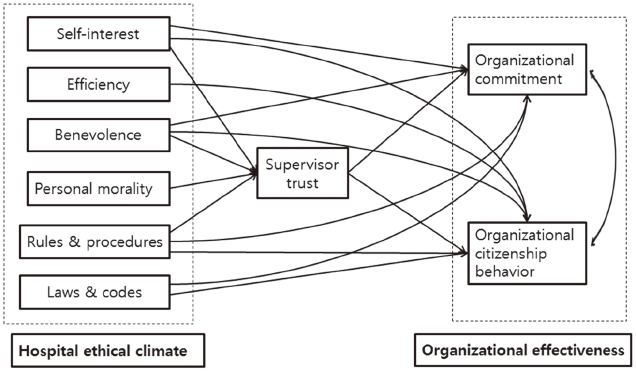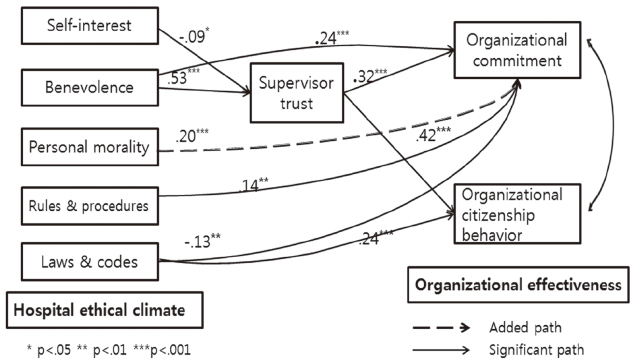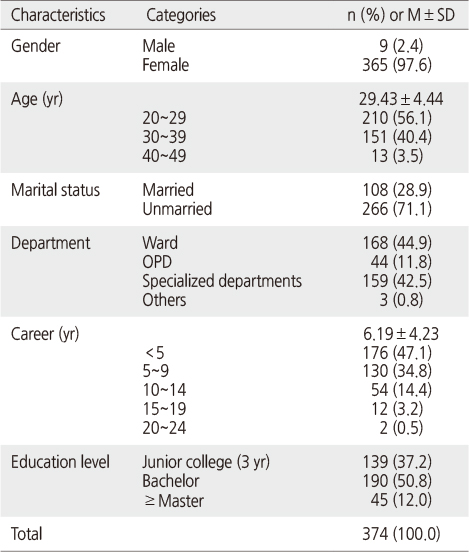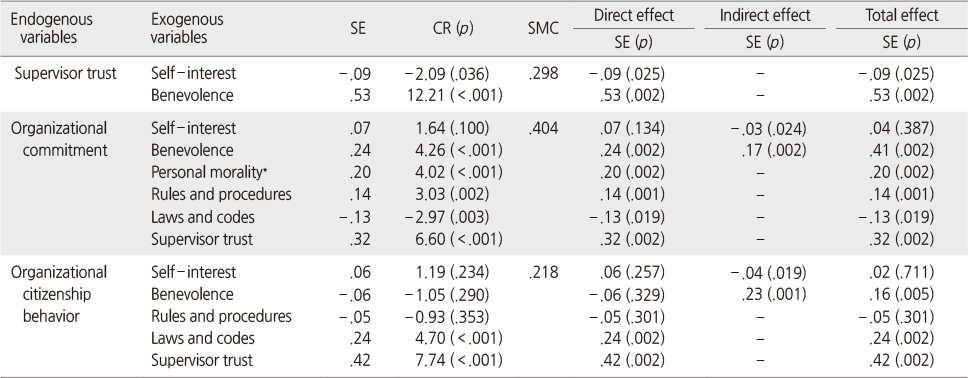Articles
- Page Path
- HOME > J Korean Acad Nurs > Volume 46(6); 2016 > Article
-
Original Article
- Path analysis of the Influence of Hospital Ethical Climate Perceived by Nurses on Supervisor Trust and Organizational Effectiveness
- Yoon Goo Noh, Myun Sook Jung
-
Journal of Korean Academy of Nursing 2016;46(6):824-835.
DOI: https://doi.org/10.4040/jkan.2016.46.6.824
Published online: December 30, 2016
1Department of Nursing, Changwon National University, Changwon, Korea.
2College of Nursing·Institute of Health Sciences, Gyeongsang National University, Jinju, Korea.
- Address reprint requests to: Jung, Myun Sook. College of Nursing, Gyeongsang National University, 15, Jinju-daero 816beon-gil, Jinju, Gyeongsangnam-do, 52727, Korea. Tel: +82-55-772-8256, Fax: +82-55-751-8711, msjung@gnu.ac.kr
© 2016 Korean Society of Nursing Science
This is an Open Access article distributed under the terms of the Creative Commons Attribution NoDerivs License. (http://creativecommons.org/licenses/by-nd/4.0/) If the original work is properly cited and retained without any modification or reproduction, it can be used and re-distributed in any format and medium.
Abstract
-
Purpose
- The purpose of this study was to analyze the paths of influence that a hospital's ethical climate exerts on nurses' organizational commitment and organizational citizenship behavior, with supervisor trust as the mediating factor, and verify compatibility of the models in hospital nurses.
-
Methods
- The sample consisted of 374 nurses recruited from four hospitals in 3 cities in Korea. The measurements included the Ethical Climate Questionnaire, Supervisor Trust Questionnaire, Organizational Commitment Questionnaire and Organizational Citizenship Behavior Questionnaire. Ethical Climate Questionnaire consisted of 6 factors; benevolence, personal morality, company rules and procedures, laws and professional codes, self-interest and efficiency. Data were analysed using SPSS version 18.0 and AMOS version 18.0.
-
Results
- Supervisor trust was explained by benevolence and self-interest (29.8%). Organizational commitment was explained by benevolence, supervisor trust, personal morality, and rules and procedures (40.4%). Organizational citizenship behavior was explained by supervisor trust, laws and codes, and benevolence (21.8%).
-
Conclusion
- Findings indicate that managers need to develop a positive hospital ethical climate in order to improve nurses' trust in supervisors, organizational commitment and organizational citizenship behavior.
This is manuscript is a condensed form of the first author's doctoral dissertation from Gyeongsang National University.
The authors declared no conflicts of interest.
- 1. Jeong JH, Kim KH, Kim JS. The risk factors influencing turnover intention of nurses. J Korean Acad Nurs Adm. 2008;14(1):35–44.
- 2. Noh YG, Jung MS, Lee YS. Nurse's job satisfaction and organizational commitment according to hospital ethical climate types. J Korean Acad Nurs Adm. 2013;19(4):513–524. Article
- 3. Victor B, Cullen JB. A theory and measure of ethical climate in organizations. In: Frederick WC, editor. Research in corporate social performance and policy. Greenwich, CT: JAI Press; 1987. p. 51–71.
- 4. Victor B, Cullen JB. The organizational bases of ethical work climates. Adm Sci Q. 1988;33(1):101–125.Article
- 5. Nam MJ, Kwag SH. The effect of individual-organizational variable on ethical decision-making process in the organizational context. Manag Inf Syst Rev. 2011;30(1):39–69.Article
- 6. Reilly BJ, Kyj MJ. Economics and ethics. J Bus Ethics. 1990;9(9):691ArticlePDF
- 7. Yoo BA. The impact of employee's ethical climate perception on organizational citizenship behaviors: Focused on the moderating and mediating effect of trust [dissertation]. Incheon, Inha University. 2007;1–110.
- 8. Jung YM. A study on the effects of the perception of organizational members for the ethical climate on job satisfaction, organizational commitment and organizational citizenship behavior: Focused on the mediating role of trust in superior [master's thesis]. Gyeong-San, Yeungnam University. 2006;1–136.
- 9. Lee SS, Lee SY, Cheong IS. The effect of ethical climate on the job satisfaction and organizational commitment. J Organ Manage. 2008;32(2):1–21.
- 10. Cullen JB, Parboteeah P, Victor B. The effects of ethical climates on organizational commitment: A two-study analysis. J Bus Ethics. 2003;46(2):127–141. ArticlePDF
- 11. Martin KD, Cullen JB. Continuities and extensions of ethical climate theory: A meta-analytic review. J Bus Ethics. 2006;69(2):175–194. ArticlePDF
- 12. Tsai MT, Huang CC. The relationship among ethical climate types, facets of job satisfaction, and the three components of organizational commitment: A study of nurses in Taiwan. J Bus Ethics. 2008;80(3):565–581. ArticlePDF
- 13. Huang CC, You CS, Tsai MT. A multidimensional analysis of ethical climate, job satisfaction, organizational commitment, and organizational citizenship behaviors. Nurs Ethics. 2012;19(4):513–529. ArticlePubMedPDF
- 14. Dirks KT, Ferrin DL. Trust in leadership: Meta-analytic findings and implications for research and practice. J Appl Psychol. 2002;87(4):611–628.ArticlePubMed
- 15. Laschinger HKS, Shamian J, Thomson D. Impact of magnet hospital characteristics on nurses' perceptions of trust, burnout, quality of care, and work satisfaction. Nurs Econ. 2001;19(5):209–219.
- 16. Lee SY. The relationships of superior's leadership to supervisory trust and organizational commitment of nurses. J Korean Acad Nurs Adm. 2007;13(2):208–218.
- 17. McCarthy J, Deady R. Moral distress reconsidered. Nurs Ethics. 2008;15(2):254–262. ArticlePubMedPDF
- 18. Hart SE. Hospital ethical climates and registered nurses' turnover intentions. J Nurs Scholarsh. 2005;37(2):173–177. ArticlePubMed
- 19. Chen CH, Wang SJ, Chang WC, Hu CS. The effect of leader-member exchange, trust, supervisor support on organizational citizenship behavior in nurses. J Nurs Res. 2008;16(4):321–328.ArticlePubMed
- 20. Lee H. Related factor of organizational effectiveness in hospital: Self-efficacy, faith in supervisor [dissertation]. Seoul, Yonsei University. 2003;1–139.
- 21. Yu JP. The concept and understanding of structural equation modeling. Seoul: Hannare Publishing Co.; 2012. p. 1–567.
- 22. Park J, Yun E, Han S. Factors influencing nurses' organizational citizenship behavior. J Korean Acad Nurs. 2009;39(4):499–507. ArticlePubMed
- 23. Cullen JB, Victor B, Bronson JW. The ethical climate questionnaire: An assessment of its development and validity. Psychol Rep. 1993;73(2):667–674. ArticlePDF
- 24. Mowday RT, Steers RM. The measurement of organizational commitment. J Vocat Behav. 1979;14(2):224–247. Article
- 25. Williams LJ, Anderson SE. Job satisfaction and organizational commitment as predictors of organizational citizenship and in-role behaviors. J Manage. 1991;17(3):601–617. ArticlePDF
- 26. Cook J, Wall T. New work attitude measures of trust, organizational commitment and personal need non-fulfilment. J Occup Psychol. 1980;53(1):39–52. Article
- 27. Yu JP. A misunderstanding and fallacy of structural equation modeling. . Seoul: Hannarae Publishing Co.; 2014. p. 1–318.
- 28. Kim JY, Park SE, Lee MR. An empirical study on the relationships among ethical leadership, trust and organizational citizenship behavior. Korean J Resour Dev. 2010;13(2):1–19.
- 29. Woo CB, Yoon TI, Park HS. A study on the impacts of perceived ethical climate on the job satisfaction and organizational commitment. J Hum Resour Manag Res. 2010;17(1):289–311.
- 30. Gu MO, Cho YA, Cho MS, Eun Y, Jeong JS, Jung IS, et al. Adaptation of intravenous infusion nursing practice guideline. J Korean Clin Nurs Res. 2013;19(1):128–142.
REFERENCES
Figure & Data
REFERENCES
Citations

- “How does workplace spirituality influence organizational citizenship behavior in the hospitality industry?”: a person-organization fit perspective
Shalini Srivastava, Pavitra Dhamija, Poornima Madan
Journal of Asia Business Studies.2025; 19(2): 339. CrossRef - EXAMINING THE MEDIATING ROLE OF ORGANIZATIONAL TRUST ON THE EFFECT OF ETHICAL CLIMATE ON EMPLOYEE VOICE IN THE HEALTH SECTOR
Gül Bilen, İbrahim Yıkılmaz, Lütfi Sürücü
Elektronik Sosyal Bilimler Dergisi.2023; 22(88): 2117. CrossRef - Social Influencing Factors of Clinical Nurses’ Patient Advocacy
Myungji Kim, Hyunkyung Choi
Journal of Korean Academy of Nursing Administration.2023; 29(4): 363. CrossRef - Relationship between Ethical Climate, Workplace Bullying, and Turnover Intention of Hospital Nurses in Korea
Mi-Aie Lee, Hyun Ju Park, Bonghwa Kim
Journal of Korean Academy of Nursing Administration.2023; 29(4): 457. CrossRef - Relationships between job burnout, ethical climate and organizational citizenship behaviour among registered nurses: A cross‐sectional study
Lyu Wang, Xiaoyu Dong, Yan An, Cancan Chen, Marion Eckert, Greg Sharplin, Jennifer Fish, Xiuzhen Fan
International Journal of Nursing Practice.2023;[Epub] CrossRef - Ethical Climate of Nurses in Korea: A Scoping Review
Yoon Goo Noh, Oi Sun Lee
Journal of Korean Academy of Nursing Administration.2022; 28(5): 487. CrossRef - The impact of clinical nurses’ perception of hospital ethical climates on their organizational citizenship behavior
Lu Wang, Dan Li, Wanhong Wei, Ting Zhang, Wenjuan Tang, Qunfeng Lu
Medicine.2022; 101(4): e28684. CrossRef - The mediating effect of ethical climate on religious orientation and ethical behavior
Zahra Marzieh Hassanian, Arezoo Shayan
Nursing Ethics.2019; 26(4): 1114. CrossRef


Fig. 1
Fig. 2
General Characteristics of Participans (N =374)
Comparison of Model Fit of Modified Model to Hypothetic Model
GFI=Goodness-of Fit Index; AGFI=Adjusted Goodness-of Fit Index; CFI=Comparative Fit Index; TLI=Turker-Lewis index; RMR=Root Mean Square Residual; RMSEA=Root mean square error of approximation.
Standardized Estimates, CR, SMC, Standardized Direct, Indirect, and Total Effect for Modified Model
SE=Standard estimates; CR=Critical ratio; SMC=Squared multiple correlation.
GFI=Goodness-of Fit Index; AGFI=Adjusted Goodness-of Fit Index; CFI=Comparative Fit Index; TLI=Turker-Lewis index; RMR=Root Mean Square Residual; RMSEA=Root mean square error of approximation.
SE=Standard estimates; CR=Critical ratio; SMC=Squared multiple correlation.
 KSNS
KSNS
 E-SUBMISSION
E-SUBMISSION





 Cite
Cite

